Minor astrological aspects and the domain of magic

Minor astrological aspects are responsible for the “magical” chapter of an astrological chart. Their interpretations aren’t as fixed as those of major aspects but nevertheless — under certain circumstances — minor aspects may signify profound influences of strong astral energies.
The notion of “magic” has been wildly overused and overstretched. The biggest paradox with anything magical is that it’s either complete bogus and a mere fantasy, or something does happen indeed and completely defies mind’s efforts of logical explanation and rationalisation.
In other words, magic is something that either works of a complete waste of time. Many rituals produce nothing but light and sound, failing to tap into deeper mysteries behind the physical reality. It takes knowledge and often years of enduring practices to make a magical ritual that actually works, meaning that something actually shifts on the astral plane producing ripples in the fabric of the mundane reality.
Minor astrological aspects unmistakably belong to that magical and occult category. Their influence is never 100% clear. A minor aspect may sit dormant for years until a certain celestial configuration triggers it into action. In so many ways the understanding of the minor aspects rests not only on appreciation of certain principles behind magic and sacred geometry, but also on being in touch with the “mechanics” of the astral.
Before we venture any further into the domain of minor aspects, let’s look back at the major aspects.
In the beginning there were major aspects…
… and major aspects were God.
In the earlier story “Astrological aspects and sacred geometry” we had a look at the major aspects and their foundational nature.
In so many ways the power of major aspects rests on them being derived from the most basic and pure principles. The easiest way to see that is visualise the relationship between numerology and the major aspects, as illustrated below.
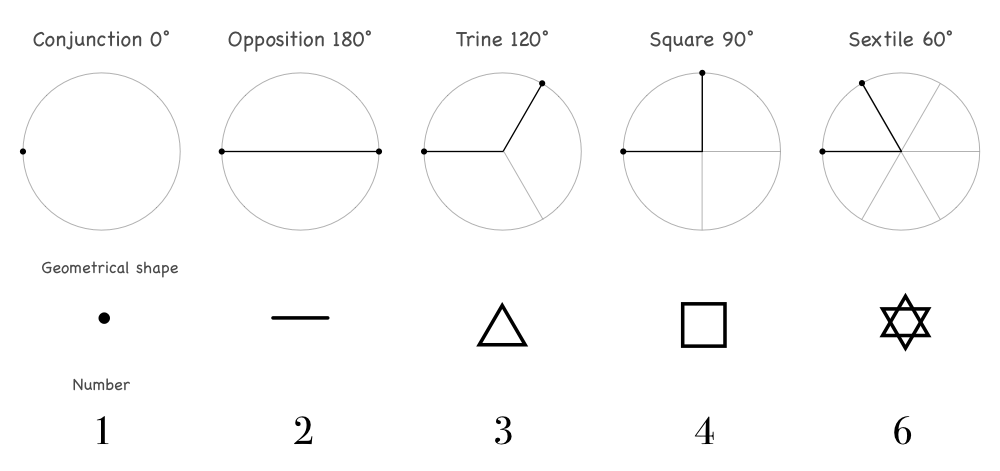
The aspects of conjunction, opposition, trine and square — the four most important major aspects directly correspond to the most “primal” sequence of numbers: 1, 2, 3, 4. The sextile aspect is connected to the number 6 and is somewhat of an outcast since it’s a composite of two trines. But still, experientially the sextile is holding up as a major aspect, there is little doubt about its nature and influence.
Following the God-creator analogy, the major aspects define the structural aspect of psychological framework for all natal charts. They act in a broad brush manner that shapes each human individuality and its major traits:
- how we relate to ourselves
- how we relate to our family members
- how we form different kinds of relationships
- how we take stuff in from the outside world
In many ways, the major aspects answer the question of “how we were made” and “what kind of personality” each of us manifests.
There is little doubt that most of our activity in this world is therefore performed in a manner that is described (but certainly not prescribed) by the major aspects in the natal chart. These aspects provide us with a “primary working toolkit” that is both consciously and automatically expresses itself in any major part of our lives: relationship to self and family, love, career and society.
Minor aspects and the inner magician
While the major aspects are of a more conspicuous nature, the minor aspects are responsible for the inconspicuous energies that can be broadly grouped into two categories:
- special abilities
- karmic forces
Note that these categories can be also described as “I do” and “I did”. The minor aspects convey the acts of doing or reaping the effects of previous deeds.
Star, the symbol of magic and occult
This world never ceases to astound us with its ever increasing complexity that comes directly from the domain of astral forces that motivate and move humanity at large.
The potent sharpness of astral energies has its own symbol — it’s a star. There are many types of stars and they all have their subtle differences.

The self-intersecting geometric nature of all stars is what makes them so different from he primal shapes behind the numbers 1, 2, 3, 4 and astrological aspects of conjunction, opposition, trine and square.
The stars are very different from the major foundational shapes, stars are in charge of forces of a different kind — magical or occult powers.
Magic begins with the number 5
The first star among many others is a 5-point star also known as a pentagram, where “penta” is a Greek word for five and “gramme” means line. All stars can be named using “something-gram” word that describes how many lines form the star shape.
The pentagram is the most potent of all occult symbols. The power of pentagram has been extensively used by numerous human organisations to symbolise their relationship to the force that “can do” things:
- white magic
- black magic
- communist state and military
- capitalist state and military
- sports and other competitive activities
… and many other areas of human activities used this symbol while either understanding or being ignorant about its meaning.

The pentagram star relates to other stars in a similar way as circle relates to the foundational objects described by the numbers 1, 2, 3, 4. The five point star is the primary “first” star and all other stars inherit from its nature and archetype.
Introducing minor aspects
Since there are infinitely many ways to divide a circle, the number of minor aspects is also nearly infinite. The problem with such a variety is that it gets increasingly more difficult to describe the meaning of each newly introduced minor aspect.
Thus it makes sense to work with a limited set of minor aspects. The two groups of minor aspects are:
- proper minor aspects
- rare minor aspects
The proper minor aspects that are mostly understood and agreed upon by astrologers:
- Inconjunction, 150°
- Sesquisquare, 135°
- Quintile, 72°
- Biquintile, 144°
The rare minor aspects are not less powerful, it’s just exceedingly difficult to attribute specific meaning mostly due to their spontaneous and case-by-case nature of action:
- Tridecile, 108°, three deciles (see “decile” below)
- Septile, 51.4°, a seventh of a circle
- Semisquare, 45°, half a square
- Novile, 40°, a ninth of a circle
- Decile, 36°, a tenth of a circle
- Undecile, 32.7°, the eleventh part of a circle
- Semisextile, 30°, half a sextile
- Quindecile, 24°, a fifteenth of a circle
- Vigintile, 18°, a twentieth of a circle
For experienced astrologers these aspects have a meaning that was shaped by years of practice and first-hand observations. Expectedly, the interpretations will vary from one practitioner to another.
Proper minor aspects
There is a reason why the proper minor aspects have been singled out. They all are “descendants” from the number 5 and astral powers of the pentagram star.
Inconjunction, 150° = 5 × 30º, represents a distance of five Zodiac signs.
Quintile, 72° = ⅕ × 360º, represents the five points of the pentagram.
Biquintile, 144° = 2 × 72º = 2 × ⅕ × 360º, represents the five lines of the pentagram.
Lastly, there is a near exception, the sesquisquare aspect of 135º actually derives from a square, although it could also be somewhat linked to the number 5 that transforms the 90º angle into its one-and-a-half equivalent of 135º:
Sesquisquare, 135° = 90º × 1.5 = 90º and (50% of 90º)
Yes, it’s a bit of a stretch but still holds within the decimal system of numbers.
We are now going to look into meaning and symbolism of each of those aspects…
Inconjunction, 150º or 5 Zodiac signs
Inconjunction is formed by two planets positioned 150º from each other. It’s the second widest aspect after the major opposition aspect with 180º angular distance.
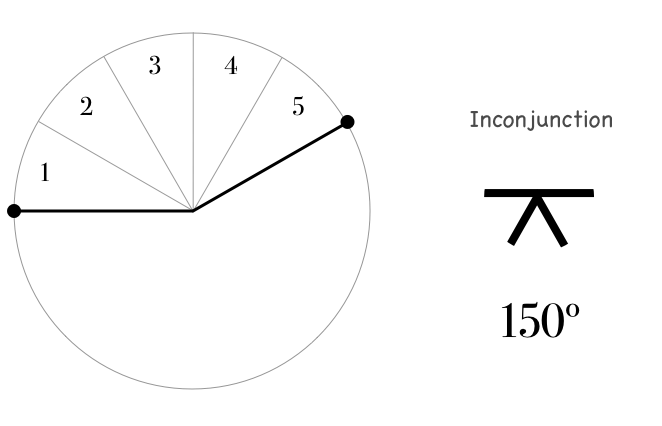
Inconjunction isn’t a regular division of a circle and therefore doesn’t have a number associated to it. At the same time the power of inconjunction stems from it being equal to the angular distance of five Zodiac signs: 150° = 5 × 30º. All aspects related to the number five produce strong influences at certain times and in certain configurations.
Inconjunctions particularly powerful in transits, they symbolically “push” the Zodiac wheel by five signs resulting in some powerful rearrangements of circumstances and often explosive changes. It’s a good idea to watch for inconjunction transits of planets that are strong in the natal chart.
Sesquisquare, 135° or a square and a half
Sesquisquare is formed by two planets being 135º apart. As illustrated by its pictogram, the sesquisquare aspect is a numeric combination of a square and a half-square.
Notice that the illustration below shows that sesquisquare is actually a four-pointed star called an “octagram” that is made out of two squares — thus becoming an intense “super square” aspect.
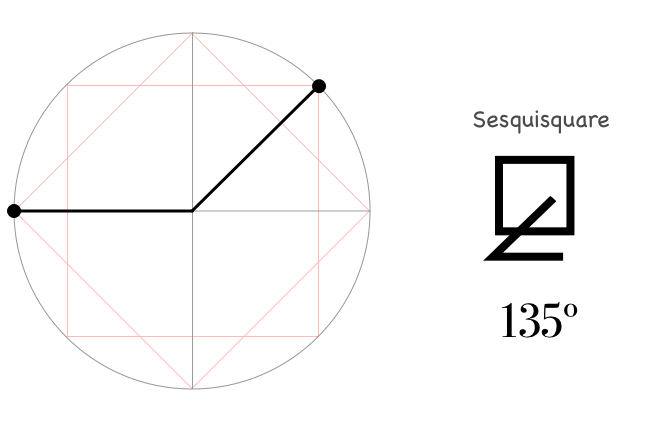
While the square aspect represents active conflict between two types of planetary energies, the sesquisquare aspect takes the conflict to the next level, the one of karma. Sesquisquare aspects often act as karmic keys in the natal chart, they point at an active yet somewhat hidden conflict of values between involved planets. Such a conflict tends to play out at a semi-conscious to subconscious levels and bringing one’s awareness to that background tension may result in powerful healing effect.
Quintile, 72º or 5 points of the pentagram
Quintile is formed by two planets located 72º apart, the aspect is directly related to number five.
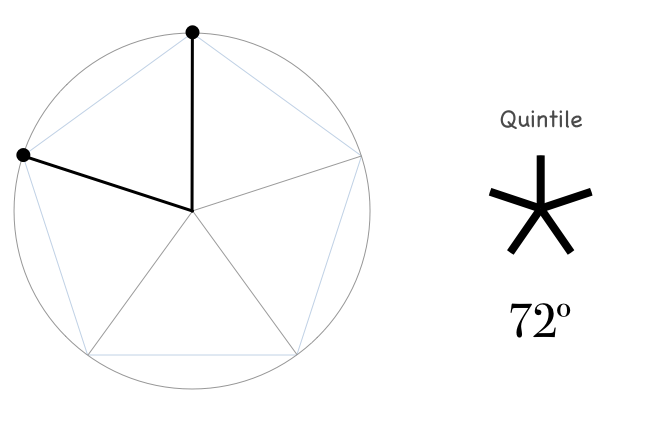
Paradoxically, the quintile aspect isn’t as powerful as its closest relative, the biquintile. Quintile is somewhat akin to sextile that is a softer version of trine.
Quintile “likes” to make, to shape, to form. Due to its native interest in associations and interdependencies, quintile is eager to create fuelled by the immediacy of ideas.
Biquintile, 144º or 5 lines of the pentagram
Biqiuintile is formed by two planets located 144º apart, meaning the distance of two quintiles. Biquintile is directly related to the number five and the powers of pentagram.
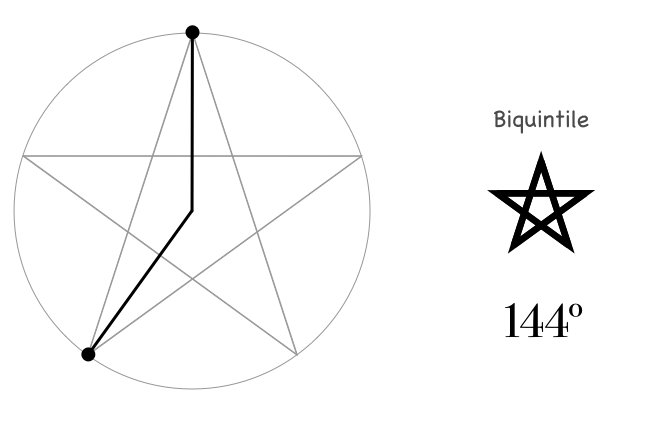
As illustrated above, five 144º degrees lines form a pentagram, the symbol for astral forces fuelling everything occult, magic and power related.
Analyse natal charts for biquintiles, especially when two biquintiles join together making a spear-like shape. Those are pointers at some very special abilities in the magical domains.
An odd case of a triquintile, 216º
A triquintile aspect certainly exists but it doesn’t make much sense in practical terms. If two planets form a biquintile they automatically form a triquintile on the other side of the circle since 2 + 3 = 5, or expressed in degrees:
144º + 216º = 360º
In other words, a triquintile is the opposite side of a biquintile.
Rare minor aspects
Rare minor aspects provide further fine-grained details to the natal chart. Yet they are not easy to grasp due to their highly nuanced nature. In order to understand and interpret the meaning of these aspects, one should devote some respectable amount of time to studying sacred geometry, symbolism and alchemy.
Septile, 51.4º and its relationship to time
Septile formed by dividing circle into seven equal parts and symbolically relates to the heptagram and its meaning that we have discussed at length in “What is Planetary Hours”.
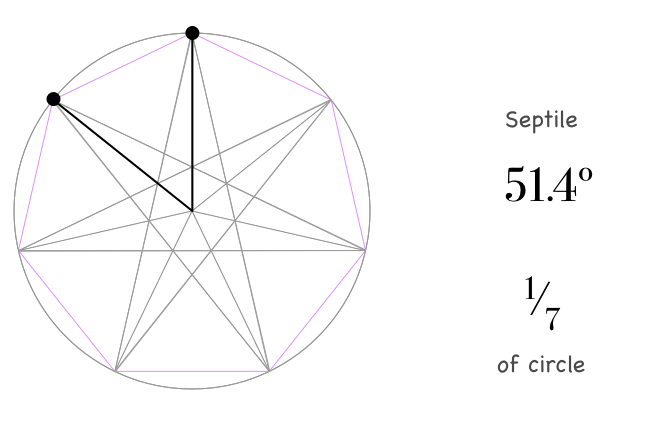
The heptagram is connected to the seven planetary spheres and the notion of unfoldment of time. The septile aspect could well be indicating our dealings with time and the overall state of incarnation that is symbolised by the sequence of the planetary spheres.
Vigintile, 18º — the smallest aspect?
When dealing with minor aspects that form regular “something-gram” stars, one can see that aspects higher than 1/36th of a circle don’t make much sense since at 10º or less planets become conjunct.
The smallest practically applicable aspect is perhaps the vigintile, 18°, a twentieth of a circle.
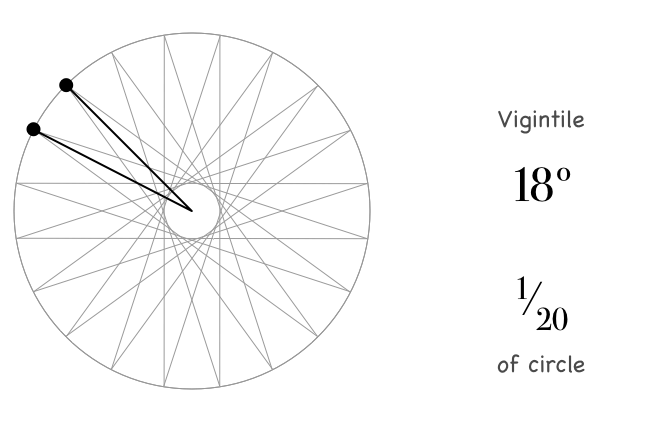
Prominent astronomer Johannes Kepler, who was also a prolific astrologer, introduced most of minor aspects including the vigintile.
Decile, 36º and novile, 40º — a case of being too close
Decile is formed by two planets positioned 36º apart. Novile is formed by a 40º angular difference. Do you see the problem?
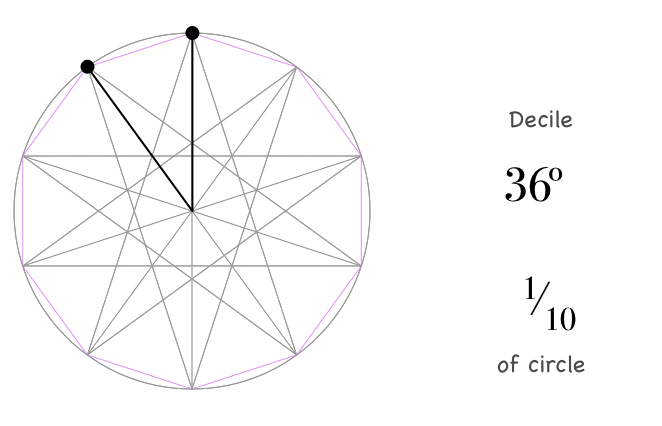
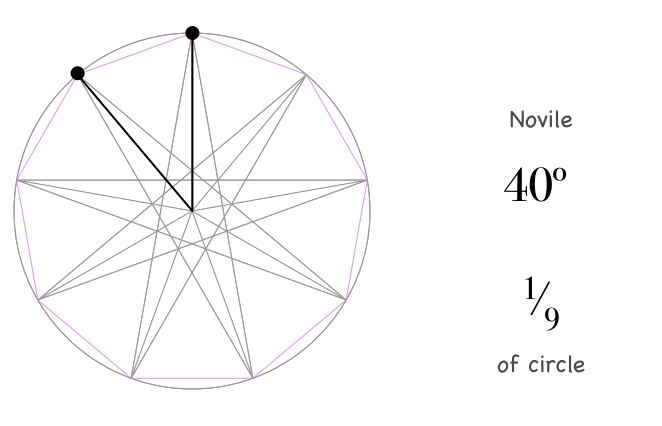
The problem is that the planetary positions for both aspects are simply too close to each other with only 4º difference. This calls for a very careful attitude towards interpreting those fine-grained aspects, especially when it comes to planets that have an inherently imprecise position. The margin of error being too high will not add real value to the natal chart interpretation.
The Black Moon is a case is point. Its celestial position is never exact due to its “imaginary” purely geometrical nature. The Moon orbit is rather irregular and the Black Moon point that is defined in terms of the Moon orbit follows the case. The advise is to stay away from using rare minor aspects, or any aspects that require tight orbs, in cases like this.
Magic meets sacred geometry
The topic of minor aspects is brimming with mysteries and promises of “specialness”. While those aspects do add a good amount of spice and suspense to the chart interpretation, it is wise to stay somewhat realistic and don’t expect them to work in every case — just like magical rituals they produce results only under certain and mostly rare alignments.
What the minor aspects really offer is the entry point into the domain of sacred geometry and symbolism that is directly connected to the notions of magic and occult. Understanding those principles will take any astrologer further in their art and craft by providing deeper insights into the workings of the Universe.
26 Comments
darren thomas
awesome. post .. Tme nomad is awesome software .. Thanks ..
Joe Schirtzinger
This post is backwards. It places the man as the beginning of magic and therefore the number 5. It really begins with the 0 or 1.
Time Nomad
Not really, the article doesn’t place humans anywhere specific. Human consciousness spans all the way from the upper echelons (the Universe, Spirit, God or whatever one prefers to call it) to the Earth itself, and sometimes even further down.
“Magic” is a domain in its own right, it’s not unique to humans, but rather a universal principle of action applicable to all beings.
char555
Two sesquisquares linked by a square (as in Jupiter / Neptune right now) make an aspect pattern called “Thor’s Hammer”. Alice Portman and Linda Reid have written about it. Most of the images in your very interesting article aren’t being displayed on my screen, in fact the only one I can see is the pentagram right at the start. Very frustrating! I’ve tried to fix that but have not succeeded. If you have any ideas about it, I’d be grateful to hear them.
Time Nomad
Indeed, the “Thor’s hammer” pattern is happening right now, I am adding a chart for July 2019 below to illustrate your point. The next story titled “Minor astrological aspects and the domain of magic” is covering the Thor’s hammer pattern.
The “Thor’s hammer” pointing at Mars makes me feel somewhat uncomfortable taking the currently brewing world conflicts into consideration. Especially knowing that Mars is also square to Uranus. Some seriously dangerous fire!
char555
Vitruvian Man…
Shawntay Crawford
Thank you so much again for another awesome informative article. I wish you had an app for Androids! Lol I’m not an iPhone fan. Maybe someday right?? 🙏🏽 thanks again!
Brittany
Help! @Time Nomad… I hope you still monitor your comments. I pulled my birth chart with all planets and asteroids included and quincunxes as well. The chart produced has a 5-pointed star shape created by the quincunxes. I have tried to research this phenomenon, but I am only getting results of blogs and those who have a fascination or obsession with it… I have an intuitive feeling that this has a profound meaning for me about the transformation of trauma and ancestral wounds into healing power for myself and others… but I cannot prove this. Please give me your opinion/advice on this phenomenon. Thanks.
Time Nomad
Hey Brittany, I can offer a few points but please treat them as my humble opinion that doesn’t necessarily reflect the reality. Astrology is inherently complex. Plus… that’s without seeing your chart so there’s a LOT of gaps in my understanding of your astral profile.
Quincunx or inconjunction is a 150º aspect, a shift across 5 zodiacal signs. That’s certainly speaks about rearrangements as the zodiacal wheel gets turned and shuffled. May mean a life time of changes and reorientation towards future incarnations (if you believe in them).
Generally speaking, the strongest star is made by biquintiles (144º) that’s the pentagram, a classical symbol of occult powers. Charts of some powerful people, both spiritual and anti-spiritual, have nearly complete pentagrams. But that’s extremely rare.
In the case of your chart, I’d recommend to start without asteroids and minor planets. See what kind of geometry you get. Most of the stuff comes from classical planets. Asteroids are fancy but too tiny compared to real celestial giants.
Then look at major aspects between the planets and see what kind energies are there. You may get quite far with that kind of interpretation technique. And after all, what you feel is true, you know what you know – no matter what any astrologer would tell you!
Vivien
Me too Brittany ! Thank you for asking. My grand quintile pattern wouldn’t be complete as the quintile from Venus to the moon is 6degrees rather than 3 degrees orb. However Ceres/Demeter at 3 degrees Gemini is conjunct moon at nine Gemini which has always felt important to me. A case of taking the asteroid Goddess energy of Great Mother into consideration with gratitude rather than relying on everyday “moon” in pondering the gifts and challenges. The bi quintile from Chiron in Cap to the moon Gemini is exact however, so it feels like a bit of a corridor between 3and 9 degrees?? Best
Divine Conjurer
Moon In 0 aries Desc in 6 sag Jupitor in 3 leo Asc in 6 gemini Mercury in 5 aquarious
Deseño
Excellent article. Exactly what I was looking for. I use Time Nomad app every day. Couldn’t live without it. Student of esoteric astrology here. I use it to time my magickal workings
Occult Principles
Highly descriptive post, I enjoyed that a lot. Will there be a part 2?
PeeRo
This just gave me an entry key into the Quintile and BiQuintile aspects. The Quintile being five points (aka dots), with the affinity for interdependencies and associations, leading to a desire to create, to shape and to form. A point, represented by dots, is the beginning, sorta, which contains all that is created. My vocabulary may not be precise, but I hope you understand what I mean. For the BiQuintile, five lines. A line is the distance between two points. That means moving away from the initial point onto the next point, but in such a way that there isn’t a deviation totally from the goal which the first point is trying to achieve. Sort of an improvement of the first point or dot. Whereas the Quintile initiates a creative process from the point or dot, I see BiQuintile as having a letting go/ moving on quality with the goal of mitigation or improvement of the Quintile process by connecting the dots and drawing the line.
Time Nomad
Indeed, one can say that the Quintile is ideation / gestation while the Biquintile is the “magic” of the consciousness that emanates. It’s an interplay between two fives: five points and five lines. A move from conception to initiation.
Marie
Would you be willing to look at a pentagram and Yod which is present in my chart, and tell me more about the angles/degrees? I have a pentagram in my chart, near perfect, but not perfect - I also have a perfect Yod going down the middle of it. I’d love to understand more about the specific degrees of the pentagram in my chart but I’m unable to measure them precisely..
Time Nomad
That’s a question to ask a trained astrologer. It’s impossible to say anything without seeing the actual natal chart. Many pentagrams are not very meaningful due to the planets and points involved. Same applies to the yod – what planets are forming it?
Rose Salt
Hi I notice that your symbol for a Quintile is represented differently elsewhere online.
Time Nomad
Some astrological symbols have a number of variations. Time Nomad uses the five line symbol for the quintile to pass the geometrical meaning of the aspect - the division by five. By design Time Nomad gravitates towards a more symbolic visual language. Another example, can be the Pluto pictogram.
Koa
Thank you so much! I’ve found this app so powerful, elegant and educational. What a wonderful contribution 🙌
R
Please help me interpret a 108 degree aspect (applying) Placidus Sun at 17.55 degree of Cancer in 5th House Neptune(R) at 6.10 degree Scorpio in the 8th House
Time Nomad
108º is a tridecile/tredecile or 3 times 1/10 of a circle which gives the ratio of 3/10 or 10/3 which produces either 0.3 or 3.33333… the number 3 is seen as a divine symbol, the world of the gods, the sky of the gods. Having Neptune in the 8th could point at special theurgical abilities, a practical connection to the heavenly realms. How much that is dormant or active is another question. But the energy is there and that’s supported by the Sun creative momentum.
Jomotion
My radix has a chain of a particular aspect. Uranus to Saturn to Mars to NNode to Neptune to Venus are each aligned in a chain by 165º(.08º-1.39º from partile). They seem to be several planets short of an eleven pointed star. I’ve corresponded with Ricki Reeves who authored “The Quindecile”’ her name for the 165º aspect. She describes it as being an obsessive-compulsive influence. Of course, 163.6͞3º would form a precise “star”. Have you used the quindecile? Do you think the magical undecile applies here?
Time Nomad
I haven’t done much work with 165º possibly because that’s is just another way to say 15º aspect. As with many aspects it’s all about the way one looks at them.
Generally speaking aspects don’t exactly resolve in specific psychological features. Aspects are more like certain types of connectors between planetary energies, which in turn do result in psychological features in an individual.
On the practical side, perhaps finding time when two planets are 165º in the sky and tuning into them to see what would that aspect mean?
Marticoari
I have pentagram in my natal chart.3 yods,cradle and t square 14.8.1988 7:45AM Split Croatia
M
Kod mene je nekakav peterokut (3 sextile s lijeve strane natala i 2 kvadrata s desne).Jedna kolijevka,tri Joda i jedan T kvadrat tvore pentagram u tome peterokutu.Jaka 4,8 i 12 kuća.Vidi 14.8.1988 7:45 ST